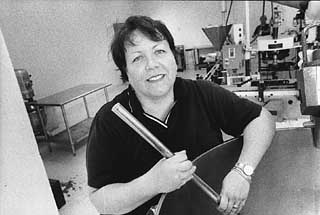https://www.austinchronicle.com/food/1999-08-27/522626/
Queen of Condiments
By Virginia B. Wood, August 27, 1999, Food
|
|
The idea for Austin Kitchen Inc. evolved from that meeting. Gail Calder, Kathy O'Kelley, Earl Clardy, Mary Anne Ralls, and Mellen West made Neblett an offer on his equipment at the Southeast Austin commercial kitchen/warehouse and took over in September 1998. "We finally sealed the deal in the hallway at last year's Fiery Food Show," Calder recalls, "and then negotiated new business agreements with all the customers." Each of the partners has certain duties, and Gail Calder runs the kitchen. She is a graduate of the "Better Process Control School" course taught by Dr. Al Wagner at Texas A&M. "We've had a very rapid learning curve this first year, and our main concern has been to make the existing customers happy," Calder says with pride, adding that Wagner is an invaluable resource for problem-solving only a phone call away. Calder and the regular staff of six people keep three big kettles bubbling every day at Austin Kitchen, turning out batches of cooked salsa, condiments, dips, barbecue sauces, and salad dressings.
The commercial kitchen/warehouse of Austin Kitchen is located in a business park on Todd Lane. (It was once the home to Jardine's Foods, an interim step between production in the Jardines' garage and their ultimate million-dollar Buda facility.) Of the 7,500 square feet, 2,000 square feet is devoted to kitchen space; there is a spice room, offices, and a bathroom, plus plenty of warehouse space for the condiment products of nearly 20 small companies. Austin Kitchen prepares, bottles, labels, and boxes the condiments, then it's the job of the individual company owners to find their product's special niche in the crowded marketplace. "We process the orders and have product ready for distributors such as Gourmet Award or Tree of Life to pick up at our warehouse, but the customer has to sell the product themselves," says Calder, explaining that distribution by a major company is a big, important hurdle for a small outfit to scale.
But before the newest winner of the annual Austin Chronicle Hot Sauce Contest can even consider product distribution, there's a series of important steps necessary to finding the right company to produce and pack the precious new winning recipe. Gail Calder explains the process involved in going from a quart of salsa to 100 gallons. The prospective new salsa maker will need a license from the Texas Department of Health, which requires a $50 fee for each different product. When they call on Calder at Austin Kitchen to review the recipe with her, a confidentiality and nondisclosure agreement is signed to protect the prospective customer's recipe. If all goes well at that meeting, Calder will prepare a test batch for a fee. The customer then tastes Calder's version of the recipe until it suits him. Once both parties are satisfied, the "packing fee" is negotiated based on the cost of ingredients, production, bottling, labeling, and shipping materials. Samples of the potential product have to be tested at an independent laboratory to determine qualities like pH balance, acidity, and shelf life, there's label art and nutritional information to consider, product liability insurance to purchase. All of these things have to happen before a jar of salsa rolls off the assembly line at Austin Kitchen and into a grocery store near you.
"We've never advertised, but we get calls at least once a week from people who are interested in putting some product on the market," Calder says. But not everyone is cut out for this kind of endeavor. "I really have to be convinced they understand how much work is involved and are willing to invest the time, money, and commitment in the process. Some people realize they'd rather just make salsa for their family and friends." When asked about where she expects to be in five years, Calder responds, "Right here running Austin Kitchen, since I just signed a five year lease! And I'd love to learn more about commercial kitchen design." Other components of the five-year plan include upgrading the kitchen, adding ovens to accommodate the demand for baked products, a big walk-in refrigerator for more cold storage, and more giant kettles for a third cooking shift every day. "Ultimately, we'd like to license some of our customers' products and take them national, debut them at the national Fiery Foods Show, things like that." Considering what Austin's Queen of Condiments has accomplished in the last five years, you can bet your secret salsa recipe that Gail Calder will do it!
Contact Gail Calder at: Austin Kitchen Inc., 3913 Todd Lane, #203; 326-2526.
Copyright © 2024 Austin Chronicle Corporation. All rights reserved.

